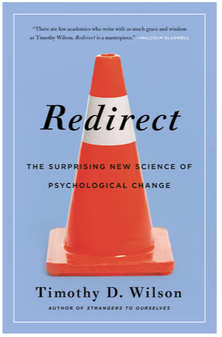She reads broadly from psychology, medicine to spirituality -- hunting down the best nuggets of wisdom so you don’t have to.
| As equal parts science lover and self-help addict, it’s not uncommon that my beloved self-help techniques prove ineffective when placed under the lens of scientific rigor. As the science of behavior change becomes stronger, it’s now easier to differentiate between which techniques are self-help “fluff” and which are powerfully transformative. As new research emerges, I’ve had to retire some of my favorite personal development tools that have likely provided short term hope but not necessarily resulted in lasting change. In Redirect, psychologist Timothy Wilson, addresses this increasing conflict between what is popular in the personal development world and what actually has been proven to work in the scientific community. He reveals that many popular ways of seeking change - both personal and societal - are ineffective and even |

These updated “self-help” tools are powerful because they don’t require long term, one-on-one counseling but can be done on your own, often in a single intervention.
Here are a few of the potent transformative tools that you can try today!
STORY EDITING
With story editing you can permanently change your internal narrative using simple self-directed exercises. This internal narrative change leads to lasting behavior change that is sustained over time.
Here are 2 writing exercises that use story-editing to increase well-being.
- Best Possible Selves Exercise:
College students who did this exercise reported greater satisfaction with their lives and greater optimism up to 3 weeks later. The group that had done the Best Selves exercise also visited the health center significantly less than the control group.
- Pennebaker Writing exercise: This writing exercise is helpful when you are worried and upset about something and are having trouble letting it go. This technique was developed by James Pennebaker, a pioneering psychologist who has extensively studied the connection between writing and health.
Write about the problem you are currently experiencing for at least 15 minutes a day for 3-4 consecutive days, ideally at the end of the day and without interruption. You can write longhand, into a computer or even use a voice recorder. Write for yourself only and do your best not to worry about grammar or style. More detailed instructions here.
The Pennebaker Writing exercise or “expressive writing” has been studied extensively. Some benefits of this exercise are enhanced immune function, lower blood pressure, decreased heart rate, lowered anxiety, less rumination and fewer depressive symptoms.
DO GOOD, BE GOOD
In this strategy, rather than trying to change your thoughts or emotions, you first change your behavior, which then triggers a change in self-perception and interpretations. This new self-perception makes taking positive actions more likely in the future. This is a variation of “fake it until you make it”.
One way to do this is through adopting TINY HABITS, a behavior change method developed by Stanford psychologist BJ Fogg. By creating tiny, consistent shifts in action towards the new behavior or identity you’d like to craft you can change your self-perception and emotional state.
For example, if you meditate for 1 minute every single day, sooner or later you will build your identity as someone who is a meditator and dedicated to self-care and health. This will allow you to expand the time spent in meditation as well as more easily build other health habits.
STORY PROMPTING TECHNIQUES
Story prompting techniques direct people towards new narratives by using subtle prompts that elicit new interpretations of reality.
Examples of story prompting techniques are mindset interventions, such as growth mindset interventions in educational settings. Another example is the power of stress perception mindsets to determine how stress impacts our health. The new science of stress shows that our perception of stress (whether it’s seen as a challenge or a threat) determines how it impacts us on a physiological level.
You can experience the power of a single intervention of story prompting by watching this Ted Talk which prompts you to adopt a stress positive mindset. This act alone can change your mindset and drastically improve your relationship to stress in the long-term.
My take-aways focused mainly on tools related to personal well-being (discussed in chapter 3) but if you’re involved in education, activism, or shaping culture in anyway, read his whole book as it’s packed with resources and interventions relevant to those realms as well.


 RSS Feed
RSS Feed